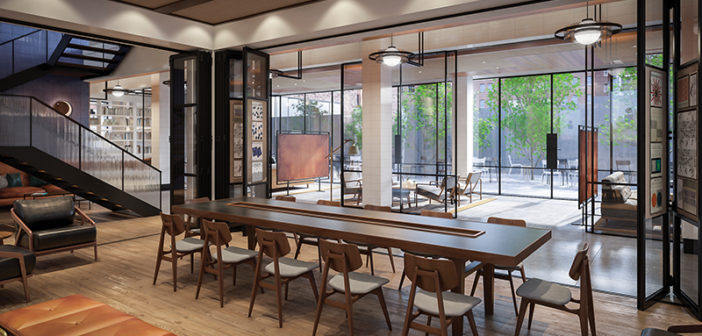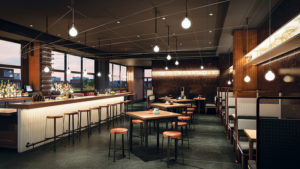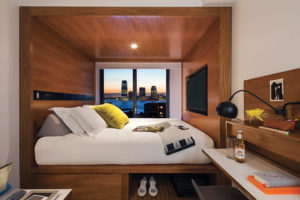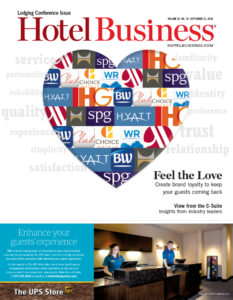NEW YORK—There’s a new kid in the hospitality playground here—Arlo Hotels. Brought to fruition by global real estate developer and investment firm Quadrum Global, the nascent brand debuted earlier this month with the 325-key Arlo Hudson Square on Manhattan’s West Side. A second property, the 250-room Arlo NoMad, is expected to open its doors Nov. 1.
Both properties have been developed by Quadrum and other partners: Eagle Point Hotel Partners in the case of the Hudson Square hotel, and Simon Baron Development and KSNY are involved with NoMad.
“Quadrum started investing in U.S. hospitality assets in 2009 and, since that time, we have gained valuable experience repositioning hotels in several gateway markets throughout the country,” said Oleg Pavlov, Quadrum founder and CEO. “In recent months, we have amassed a team of seven experienced and highly regarded veterans of the hospitality industry, each with an intimate understanding of the New York City market, to help launch this brand. This self-operated brand became a natural step in our long-term strategy of building more value-added expertise around our real estate portfolio.”
Billed as the first micro-hotels in the U.S. with four-star design, Quadrum turned to New York-based design studio Brand Bureau to conceptualize and design both hotels, with Brand Bureau’s sister firm AvroKO handling the interior design.
“The goal of the overall brand is to embrace the local communities in which the hotels exist,” said Matthew Goodrich, chief creative officer for both firms. “So, the interiors touch on this idea of travel and exploration of the local neighborhoods. You’ll also see that there is a wealth of public space, which is open not only to hotel guests, but it’s encouraged for folks who live in the neighborhood to use these spaces as well, interacting with other community members as well as travelers who come to this city from all over the world.”
So, in the crowded Manhattan landscape, where hotels seem to open as often as trains arrive at Grand Central Station, just how does a new brand stand out?
“While it’s true that hospitality product in New York is, in some neighborhoods, abundant, Arlo provides a more authentic local setting than that of the traditional large-scale hotel brand,” said Pavlov. “The communal spaces, food and drink areas, and furniture, all reflect the character of the city, allowing travelers to feel more immersed in their surroundings. Our strong belief is that travelers today choose hotels very much for the local experience and want to immerse themselves into the style, taste and smell of the particular place or city.
“We expect that Arlo Hotels will appeal to urban nomads—including, single travelers, couples and small groups—who travel lightly but are seeking social connections and memorable experiences,” he added. “But, we were careful in our design not to appeal solely to one specific demographic. We believe that Arlo provides a one-of-a-kind environment for guests of all ages and demographics, and is particularly well-suited for business travelers who require flexibility and the ability to work remotely.”
While both hotels will have similarities, there are plenty of distinct features for current and future guests of each property to explore, according to Goodrich.
“The footprint of the guestroom and the multitude of public space will not differ from property to property as that encompasses the thought of the whole brand,” he said. “Some of the materials and color schemes vary between properties, but you can definitely tell both are related venues. Both properties also have rooftop bars—Square is indoor and outdoor and NoMad is just outdoor.”
Goodrich further noted that the public spaces, in particular, are where each Arlo Hotel will stand out on its own. “The Hudson Square and NoMad properties, overall, are intended to be design cousins—not twins, meaning there are definite through lines but they each have their distinct look and feel as well,” he said. “When it comes to the public spaces, we created areas that are very flexible so they can be manipulated for any type of need. For example, on the second floor in the Hudson Square property, you have one large public space that has two different dividing screens—so it can be broken up into three different rooms, two rooms, or stay as one large space. The idea was to ensure that the hotel had as much flexibility as possible to accommodate a wide range of situations from either guests or Hudson Square/NoMad community members.”
As far as the architecture, the locations of the two hotels led to differences in the design, Goodrich noted, stating, “One of the major differences is that the Hudson Square property has more of a horizontal footprint; it’s only 11 stories tall but wraps around an interior courtyard. The NoMad property is, on the contrary, a vertical layout and is 33 stories tall. Both are particular to their respective neighborhoods. Hudson Square does not have enormous skyscrapers where, closer to Midtown, you’ll find taller buildings. Also, the Hudson Square property has a bit more of a warmer and lighter palette overall, while the NoMad property is a bit richer in color and texture.”
The guestrooms are small by design, but still feature amenities found in their larger counterparts. Space-saving offerings include fold-down desks and closets with adjustable hanging pegs.
“The overall brand of Arlo assumes that guests will spend more time in the public spaces than in their rooms, so the rooms have a smaller footprint,” noted Goodrich. “That being said, AvroKO spent a lot of time innovating creative and efficient ways of making the most use of the space while not compromising on amenities or comfort. The materials used are very high-quality and high-touch. AvroKO also designed a Jefferson bed for the Hudson Square property that feels like one’s own personal nook.”
Another highlight of the Hudson Square property is the rooftop space, which Goodrich called “breathtaking.”
“It was designed with indoor/outdoor space to be enjoyed year-round with views of the Hudson River and One World Trade Center,” he continued. “The bar will offer a handpicked selection of craft beer, cocktails and grilled snacks during warm weather months. Inspired by an artist’s loft, the space has a welcoming vibe with communal tables where new friends are born, and revolving programming that serves up a festive atmosphere throughout the seasons.”
New Yorkers—and travelers to the Big Apple—love their food, and F&B will play a major part in the Arlo experience. “The brand has partnered with celebrated chefs to create exciting restaurants. Arlo Hudson Square will feature Harold Moore’s long-awaited Harold’s Meat + Three and Arlo NoMad has teamed up with Dale Talde, David Massoni and John Bush to open Massoni, a new inauthentic Italian restaurant,” said Pavlov, who noted that the name of the brand “is streamlined and modern, representative of a brand that has been tailor-fit for a worldly and experience-driven audience. Arlo can be a nickname for more serious names like Harley, Arlene and Harlow. A grabbing, yet mostly unheard of name, Arlo is the embodiment of a concept that is decidedly casual and androgynous.”
Pavlov said there are no definitive expansion plans for the brand, but noted Quadrum owns a site in the city that could be the location for a third Arlo Hotel
“We do own a site on 38th St., between Eighth and Ninth Aves., which we are considering for ground-up development of the third Arlo,” he said. “We believe that this area will be ideally positioned to attract both tourists who want to stay close to Times Square and the Theatre District, the High Line and Madison Square Garden, as well as corporate clientele visiting the emerging office enclave of Hudson Yards.” HB




